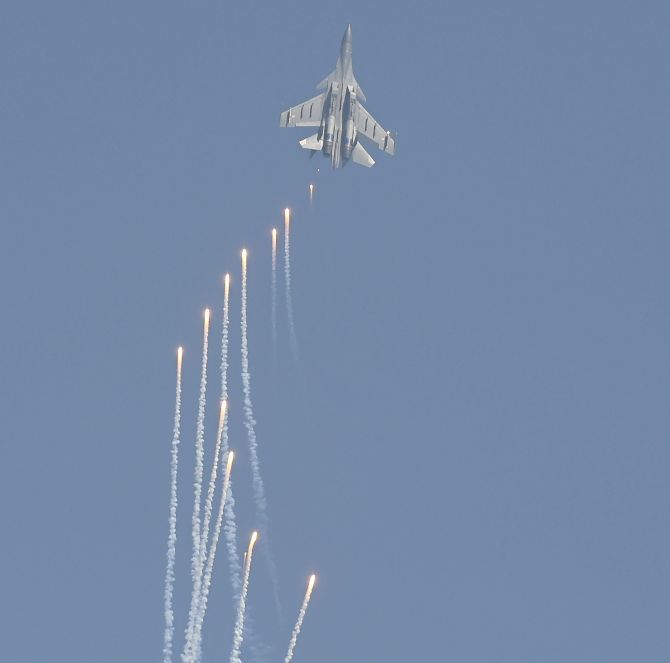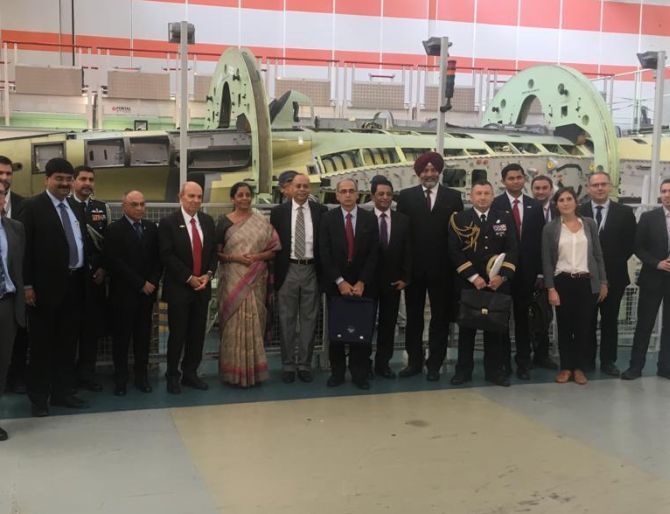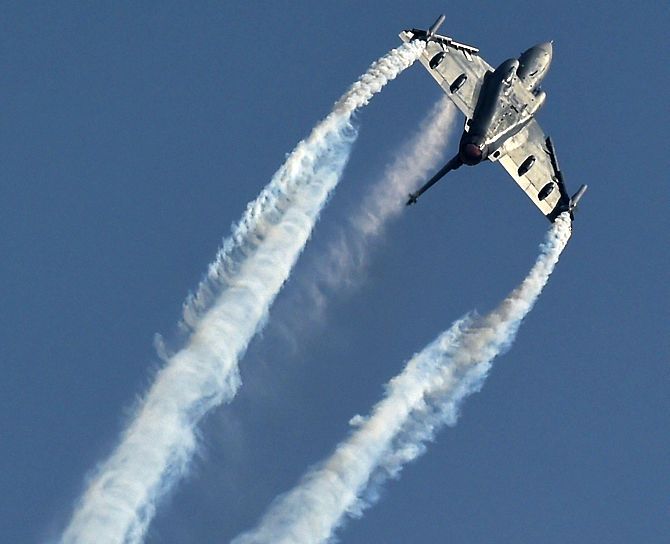The IAF faces a 'fighter gap' of 13 squadrons.
The IAF would be caught seriously short in a two-front war -- the worst-case planning contingency in which China and Pakistan attack India simultaneously, points out Ajai Shukla.

The unfolding controversy over the Rafale fighter throws up a deeply worrying question, quite separate from the Opposition's vocal charge that the National Democratic Alliance government arbitrarily bought too few aircraft, for too high a cost, to benefit a particular industrialist.
The question is this: Will the political name-calling, court cases, audits and investigations around the Rafale further clog the defence ministry's already ponderous decision-making and bring fighter aircraft procurements to a complete standstill?
Does the Indian Air Force, which already makes do with just 31 fighter squadrons against an assessed requirement of 42, now stare at the prospect of squadron numbers dropping into the twenties, before indigenous Tejas Mark 1A production kicks in to restore some respectability?
Just as the Bofors corruption allegations derailed the procurement of badly needed artillery guns for a quarter century, is the Rafale controversy likely to cause defence ministry decision-makers (wags say this is an oxymoron!) to shy away from making decisions on the purchase of all new fighters?
A further fall in squadron numbers now seems inevitable.
The IAF should already have retired eight squadrons of obsolete MiG-21s and MiG-27s, and this cannot be put off longer than the next couple of years.
To replace them, Hindustan Aeronautics Ltd is building the last two squadrons of Sukhoi-30MKIs at Nashik and two squadrons of Tejas Mark I fighters in Bengaluru.
Then there are the two squadrons of Rafale fighters that must be inducted by mid-2022.
That adds up to just six incoming squadrons against the outgoing eight, whittling down the IAF's combat strength to 29 fighter squadrons -- of which, three Mirage 2000 squadrons operate fewer fighters than their authorised 18.
The IAF, therefore, faces a 'fighter gap' of 13 squadrons -- more than 30 per cent of its authorised strength.
If 42 squadrons are the inescapable minimum needed to defend India, the IAF would be caught seriously short in a two-front war -- the worst-case planning contingency in which China and Pakistan attack India simultaneously.
Some have argued that India's defence no longer requires 42 squadrons, given that contemporary multi-role fighters carry more weapons and are far more capable than yesterday's aircraft; and those capabilities are further enhanced by force multipliers such as mid-air refuelling aircraft and airborne warning and control systems (AWACS).

The previous NDA defence minister, Manohar Parrikar, had indicated that the IAF could get by with fewer squadrons.
In January 2015, he told India Today TV that 'If 35 (fighter) squadrons can be brought to a proper shape, that would give us more time to increase the strength.'
And on April 13, 2015, three days after Prime Minister Narendra Damodardas Modi announced in Paris that he had asked then French president François Hollande to sell the IAF 36 Rafale fighters, Parrikar stated on Doordarshan: '42 squadrons is the strength approved. We should have at least 37-38 very active squadrons.'
Yet, even with these scaled-down numbers, there will be a 'fighter gap' of eight to nine squadrons after 2022. For enemy planners, this provides a predictable window of opportunity.
Towards bridging this shortfall the government initiated in April the procurement of 110 new fighter aircraft -- or six new squadrons. Even if these contracts are processed with unprecedented speed, the fighter gap will remain.
That is because the 110-fighter proposal envisages the first squadron being delivered, fully built, only after five years, or by end-2024.
The next five squadrons, which are to be built in India, will come on stream in 5 to 12 years from the contract signing, that is between 2024 and 2032. And this assumes that the contract is signed by end-2019.
Nor is the proposed Tejas Mark 1A likely to enter service fast enough to bridge the fighter gap.

In December 2017, the defence ministry sanctioned Rs 330 billion for building 83 Tejas Mark 1A -- or four squadrons of fighters -- starting from 2020-2021, with HAL's production line churning out 16 fighters, or almost one squadron, every year.
But, typically, the Tejas Mark 1A is already being delayed by mounting IAF demands.
Initially, the Tejas Mark 1A was to have four capability enhancements to the current Tejas Mark 1 -- including active electronically scanned array radar, an electronic warfare suite, a self-protection jammer, mid-air refuelling capability and easier repair and maintenance.
This year, the IAF additionally demanded 'smart multi-function cockpit displays', a 'combined interrogator and transponder' to differentiate between friendly and hostile aircraft, a digital map generator and an improved radio altimeter.
Integrating these systems onto the Tejas Mark 1A requires comprehensively redesigning its mission computer -- a delay of three to four years.
Such amateurish planning stems from a worrying inability within the military and the defence ministry to anticipate equipment retirements, and to identify, evaluate, budget for and procure the equipment needed to fill those gaps.
Instead of launching a new competitive procurement initiative for 110 fighters on exactly the same lines as the failed procurement of 126 Rafale fighters, there is a need to step back and examine our procurement record.
Historically, India has been successful in only three categories of procurement.
First, in the purely indigenous development of strategic weapons systems like ballistic missiles, where watertight international sanctions forced Indian technologists to indigenise practically every dimension of these systems.
With no option available for import, the Defence Research and Development Organisation conceived the Integrated Guided Missile Development Programme and translated it into four successful missile systems -- the Agni and Prithvi ballistic missiles, the Akash air defence missile and the Nag anti-tank missile.
The second successful procurement model has involved the DRDO working with foreign technology partners and India's private sector, with the latter two compensating for gaps in the DRDO's own capability and capacity.
Examples of such successes are the Indo-Russian BrahMos and Indo-Israeli Long Range Surface to Air Missile, the Pinaka rocket launcher, Advanced Towed Artillery Gun System and the Arihant-class nuclear submarine.
The third successful procurement model has involved government-to-government deals, such as the T-90S tank, C-17 Globemaster III aircraft and a myriad of combat aircraft, such as the Sukhoi-30MKI, Mirage 2000 and numerous MiG-series fighters.
In these procurements, the government jettisoned ambitious multi-vendor contests and instead consulted the relevant service to identify suitable weapon equipment.
Trials were conducted where necessary and the deal then concluded with the vendor country -- for either an off-the-shelf purchase or for building the equipment in India with transferred technology.
With the first model irrelevant and the second model already adopted for the Tejas Mark 1A, an expeditious purchase of 110 fighters could best be executed through the government-to-government model.
There is little time for cumbersome technical and trial evaluations of multiple fighters on offer, which, in any case, ignores broader factors such as the simultaneous procurement of 57 naval multi-role combat aircraft for India's aircraft carriers.
Bunching these two procurements together would provide a better deal, something that has been ignored so far.
Additionally, aspects of strategic and technological partnership must feed into this multi-billion dollar decision.
To a government already burned by the Rafale allegations, this may seem fraught with peril.
But all it requires is intensive consultations with the military, rather than the political unilateralism that has proved damaging to the government in buying the Rafale.













